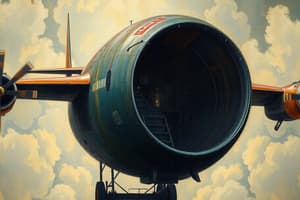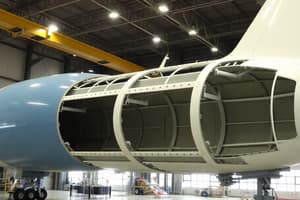Podcast
Questions and Answers
What are the types of fuselage construction?
What are the types of fuselage construction?
- Quadrocoque
- Semi-monocoque (correct)
- Monocoque (correct)
- Tricoque
What is a monocoque fuselage?
What is a monocoque fuselage?
A monocoque fuselage is a structure where all loads are carried by the skin, with only light internal frames or formers to provide shape. Damage to the skin can severely weaken the structure, and extra strength needs to be incorporated around areas like windows, doors, and undercarriage.
What is the purpose of bulkheads?
What is the purpose of bulkheads?
Bulkheads are similar to frames but are typically solid and may have access doors. They contribute to the fuselage's shape and support significant loads.
What is the purpose of frames?
What is the purpose of frames?
What is the purpose of stringers?
What is the purpose of stringers?
What is the purpose of longerons?
What is the purpose of longerons?
What is the purpose of the skin?
What is the purpose of the skin?
What is the purpose of doublers?
What is the purpose of doublers?
What is the purpose of floor suspension?
What is the purpose of floor suspension?
What is the purpose of floor panels?
What is the purpose of floor panels?
What are the loads on the fuselage due to pressurization?
What are the loads on the fuselage due to pressurization?
What is the pressurisation load?
What is the pressurisation load?
What is the landing gear load?
What is the landing gear load?
Describe the structural danger of a nose wheel landing with respect to fuselage loads and nose wheel strut loads.
Describe the structural danger of a nose wheel landing with respect to fuselage loads and nose wheel strut loads.
Describe the structural danger of a tail strike with respect to fuselage and aft bulkhead damage (pressurisation).
Describe the structural danger of a tail strike with respect to fuselage and aft bulkhead damage (pressurisation).
Describe the door and hatch construction for pressurized and unpressurized airplanes, including door and frame.
Describe the door and hatch construction for pressurized and unpressurized airplanes, including door and frame.
What is the advantage of a circular cross-sectional shape for the fuselage?
What is the advantage of a circular cross-sectional shape for the fuselage?
What is the advantage of a double-bubble cross-sectional shape for the fuselage?
What is the advantage of a double-bubble cross-sectional shape for the fuselage?
What is the advantage of an oval cross-sectional shape for the fuselage?
What is the advantage of an oval cross-sectional shape for the fuselage?
What is the advantage of a rectangular cross-sectional shape for the fuselage?
What is the advantage of a rectangular cross-sectional shape for the fuselage?
Explain why flight deck windows are constructed with different layers.
Explain why flight deck windows are constructed with different layers.
Explain the function of floor venting (blowout panels).
Explain the function of floor venting (blowout panels).
What are the structural limitations?
What are the structural limitations?
What is the Maximum Zero Fuel Mass (MZFM)?
What is the Maximum Zero Fuel Mass (MZFM)?
What is the Maximum Structural Taxi Mass (or Maximum Ramp Mass)?
What is the Maximum Structural Taxi Mass (or Maximum Ramp Mass)?
What is the Maximum Takeoff Mass (MTOM)?
What is the Maximum Takeoff Mass (MTOM)?
What is the Maximum Structural Landing Mass (MSLM)?
What is the Maximum Structural Landing Mass (MSLM)?
Flashcards
Types of fuselage construction
Types of fuselage construction
Monocoque and Semi-monocoque.
Monocoque fuselage
Monocoque fuselage
A structure where skin takes all loads, with only light internal frames.
Semi-monocoque fuselage
Semi-monocoque fuselage
Has stringers to support and stiffen the skin, carrying loads along their length.
Purpose of bulkheads
Purpose of bulkheads
Signup and view all the flashcards
Purpose of frames
Purpose of frames
Signup and view all the flashcards
Purpose of stringers
Purpose of stringers
Signup and view all the flashcards
Purpose of longerons
Purpose of longerons
Signup and view all the flashcards
Purpose of skin
Purpose of skin
Signup and view all the flashcards
Purpose of doublers
Purpose of doublers
Signup and view all the flashcards
Purpose of floor suspension
Purpose of floor suspension
Signup and view all the flashcards
Purpose of firewalls
Purpose of firewalls
Signup and view all the flashcards
Purpose of floor panels
Purpose of floor panels
Signup and view all the flashcards
Fuselage loads due to pressurization
Fuselage loads due to pressurization
Signup and view all the flashcards
Pressurization load
Pressurization load
Signup and view all the flashcards
Landing gear load
Landing gear load
Signup and view all the flashcards
Nose wheel landing danger
Nose wheel landing danger
Signup and view all the flashcards
Tail strike danger
Tail strike danger
Signup and view all the flashcards
Pressurised aircraft doors
Pressurised aircraft doors
Signup and view all the flashcards
Circular fuselage cross section
Circular fuselage cross section
Signup and view all the flashcards
Double bubble fuselage cross section
Double bubble fuselage cross section
Signup and view all the flashcards
Oval fuselage cross section
Oval fuselage cross section
Signup and view all the flashcards
Rectangular fuselage cross section
Rectangular fuselage cross section
Signup and view all the flashcards
Flight deck window construction
Flight deck window construction
Signup and view all the flashcards
Function of floor venting
Function of floor venting
Signup and view all the flashcards
Structural limitations
Structural limitations
Signup and view all the flashcards
Study Notes
Fuselage Construction Types
- Monocoque: Entire load-bearing structure relies on the skin, using minimal internal frames. Vulnerable to damage. Suitable for smaller aircraft.
- Semi-monocoque: Uses stringers to stiffen the skin, distributing loads. More common in larger aircraft.
Fuselage Components and Their Purpose
- Skin: Lightweight material (aluminum alloy or fabric) forming the outer shell, creating a sealed and aerodynamic compartment.
- Frames: Vertical, open-center structures that support major loads and give shape.
- Stringers: Longitudinal members that reinforce the skin, carrying loads along their length.
- Longerons: Longitudinal beams (often below the floor) that handle main bending loads.
- Bulkheads: Solid, often with access doors; give shape and support significant loads. Major ones (front/nose and rear/tail) separate pressurised/unpressurised areas.
- Doublers: Reinforcements or backing plates around cutouts (windows, etc.) or damage areas.
- Floor Suspension: Strengthening mechanism supporting the passenger or cargo floor. Modern aircraft often use sandwich or honeycomb materials.
- Firewalls: Heat-resistant barriers separating engine compartments from the flight deck and cabin to contain fire.
Fuselage Loads
- Pressurization Loads: Axial (longitudinal) and hoop (radial) stresses due to internal pressure. High pressures (up to 9.5 psi) create these stresses.
- Landing Gear Loads: Touchdown loads (compressive, side), taxi loads (forward, side), and bogie gear loads (torsional).
Fuselage Shape Considerations
- Circular: Efficient for pressurization, distributes hoop stresses evenly. Can be space-inefficient for certain passenger/cargo configurations.
- Double Bubble: Efficient use of space for passengers and cargo with less drag than a large circular fuselage. Cost-effective and, in newer designs, side-by-side bubbles are favoured due to passenger efficiency and reduced drag. Rear-mounted engines are common.
- Oval: Less efficient than circular, used for the pressure hull behind the rear bulkhead.
- Rectangular: Cost-effective and used in non-pressurized aircraft, but presents a lower weight-to-strength ratio compared to other designs.
Fuselage Structural Integrity and Limitations
- MZFM (Maximum Zero Fuel Mass): Maximum allowable weight without fuel.
- Maximum Structural Taxi Mass/Ramp Mass): Weight limitation upon commencing taxi.
- Maximum Takeoff Mass (MTOM): Maximum allowable total weight at takeoff.
- Maximum Structural Landing Mass (MSLM): Maximum allowable total weight upon landing.
Special Considerations
- Flight Deck Windows: Toughened glass panels with vinyl interlayers. Electrically conducting coating for heating and ice prevention. Direct Vision (DV) windows for backup demisting or emergency exits.
- Floor Venting (Blow-Out Panels): Automatically open to equalize pressure across the floor, prevents distortion during rapid decompression.
- Door and Hatch Construction: Plug-type doors on pressurized aircraft for pressure containment and emergency opening. Lighter construction employed on non-pressurized aircraft. Emergency escape slides may be integrated.
- Nose Wheel Landing Dangers: Potential for damage to the front pressure bulkhead and the nose wheel strut; damage to the drag link is also possible. Nose wheel collapse is also a serious possibility.
- Tail Strike Dangers: Increased risk of damage to the aft bulkhead (especially during approach and landing), leading to impacting structural integrity.
Studying That Suits You
Use AI to generate personalized quizzes and flashcards to suit your learning preferences.




